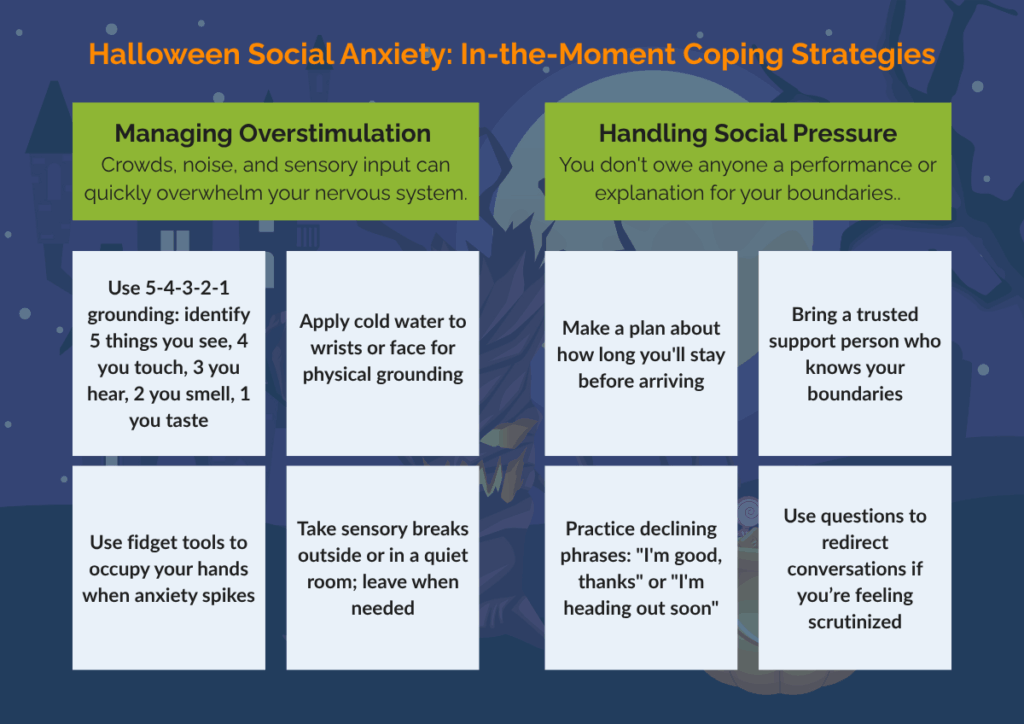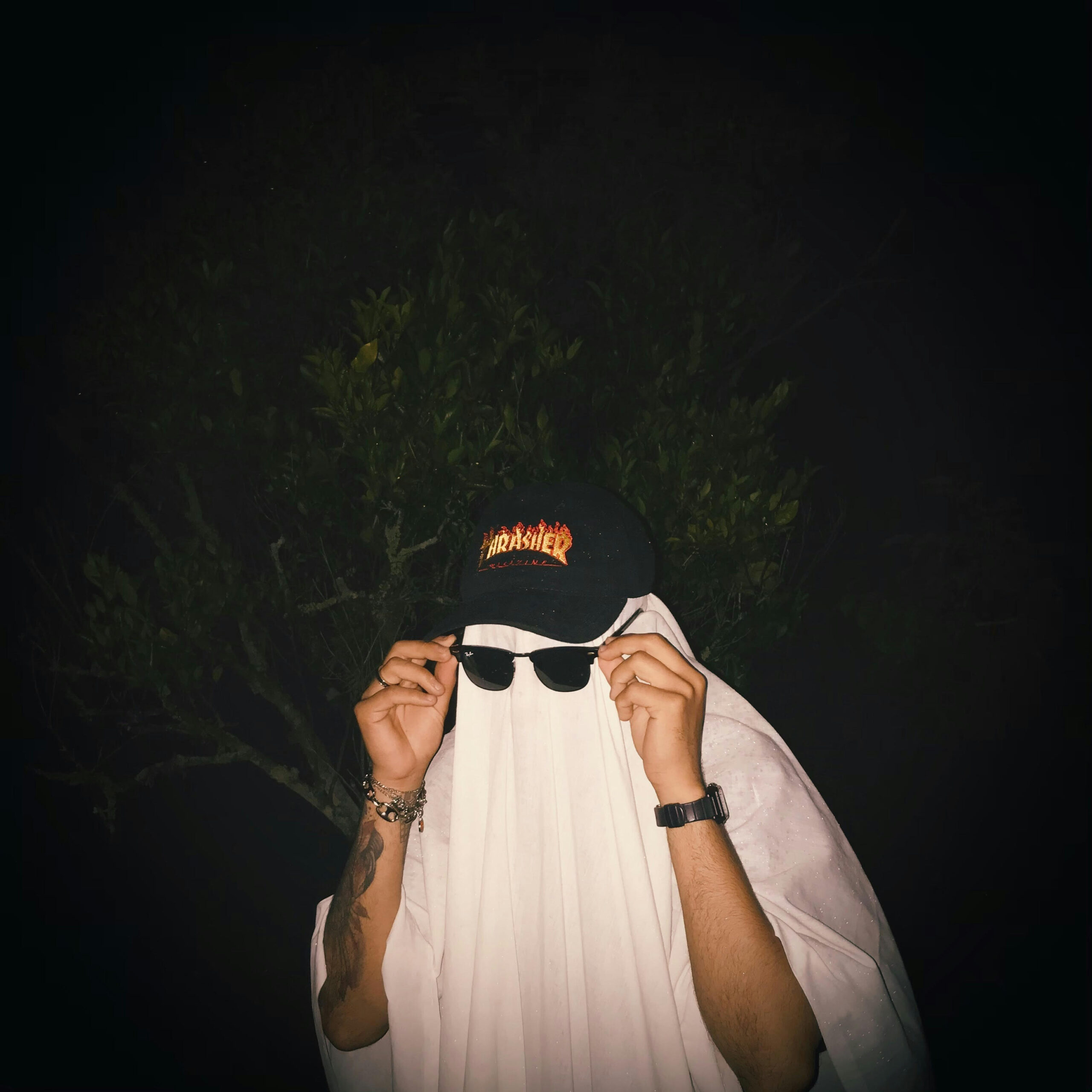Halloween is a popular holiday for children and adults alike. And it often comes with performance expectations, costume pressure, crowds, and forced socializing that can feel overwhelming. For people managing social anxiety, those demands become exponentially harder. The holiday concentrates triggers into a short window, and opting out completely isn’t realistic when Halloween shows up at work, in your neighborhood, and across every social space you occupy. Navigating it requires clarity about what you can handle and strategies for managing the rest.
What Is Social Anxiety?
Social anxiety disorder involves intense fear of social situations where you might be judged, embarrassed, or scrutinized by others. It’s not the same as shyness or introversion. Shyness might make you hesitant in new situations, but it doesn’t interfere with your ability to function. Social anxiety does.
The symptoms show up physically: racing heart, sweating, trembling, nausea, difficulty breathing. Cognitively, social anxiety generates catastrophic predictions about humiliation or rejection, hyperawareness of being watched, and persistent fear that others notice your anxiety. Behaviorally, it leads to avoidance of social situations, leaving events early, or enduring them with significant distress. Social anxiety doesn’t reflect a character flaw or weakness. It’s a recognized mental health condition that responds to treatment.
Common Social Anxiety Triggers
Certain situations consistently activate social anxiety. These triggers show up across different contexts, but they share common themes around evaluation, visibility, and social performance.
- Performance scenarios where you’re being watched or evaluated
- Fear of judgment or embarrassment that drives anticipatory anxiety before events and rumination afterward
- Small talk and forced interaction when your brain scans constantly for signs of rejection
- Crowds and overstimulation that create sensory overload and feelings of being trapped
- Being the center of attention, even when the attention is positive
Understanding your specific triggers helps you anticipate challenging situations and prepare strategies to manage them.
Why Is Halloween Particularly Challenging for Social Anxiety?
Halloween concentrates multiple social anxiety triggers into one event. Costumes invite judgment about appearance, creativity, and effort. The pressure to participate creates anxiety regardless of your choice: wear a costume and risk standing out, skip it and face questions about why you’re not being festive.
Social performance expectations intensify during Halloween. The holiday carries an implicit assumption that everyone should be enthusiastic and engaged, which makes anxiety feel more isolating when you’re struggling. Unpredictability compounds the challenge because you can’t control how crowded an event will be or whether someone will make an uncomfortable comment.
Sensory overload from noise, lights, and crowds strains an already activated nervous system. Complete avoidance isn’t realistic either. Halloween appears at work, in neighborhoods, and across social media. Attempting total isolation from a widely celebrated event often increases loneliness and reinforces the belief that you can’t handle social situations, making the anxiety about unavoidable encounters grow larger than the encounters themselves.
Taking Inventory: What Do You Want From Halloween?
Before making any decisions about Halloween, it helps to separate obligation from actual desire. Social anxiety often makes it hard to distinguish between “I should do this” and “I want to do this.” Taking inventory of your preferences, capacity, and goals creates clarity.
Consider these questions:
- Did I enjoy Halloween before anxiety became overwhelming?
- Am I saying yes out of guilt or genuine interest?
- What specific parts appeal to me versus cause dread?
- What’s my capacity right now in terms of energy, social tolerance, and sensory limits?
- What would minimal participation look like? Moderate? Full?
- What would happen if I said no entirely?
Participation exists on a spectrum. Take an honest assessment of what serves you right now. The strategies that follow apply regardless of which level you choose.
Preparation Strategies: Halloween Anxiety Checklist
Planning reduces anxiety. When you know what to expect and have strategies in place, the unpredictable parts of Halloween feel more manageable.
Before the Event:
- Work with your therapist to create a social anxiety hierarchy for Halloween situations
- Identify your specific triggers: crowds, costumes, small talk, being the center of attention, loud noises
- Plan your arrival and departure times in advance
- Create exit strategies so you know how to leave if needed
- Decide on your costume comfort level before the event
- Practice responses to common questions like “Why aren’t you in costume?” or “Why are you leaving early?”
- Choose a support person or create a check-in plan with someone you trust
Costume Considerations:
- Prioritize comfort over meeting expectations
- Consider body image concerns when choosing what to wear
- Build sensory accommodations into your costume, like noise-canceling headphones
- Have a backup plan if the costume feels too exposing once you’re out in public
The After Party: Processing The Experience
Recovery from social anxiety involves learning from experience. After Halloween, take time to reflect on what worked and what didn’t. Did your exit strategy help? Did staying longer than planned feel okay, or did it reinforce that leaving earlier next time makes sense? Was the costume choice comfortable, or would something different work better?
Nothing about your participation constitutes failure. It’s all relevant information, whether you attended and felt anxious the entire time, skipped it and felt relieved, or pushed yourself and discovered you could tolerate more than expected. Discussing these observations with your therapist helps refine strategies for future situations. Halloween happens annually, but the skills you build apply to weddings, work events, family gatherings, and any social situation that triggers anxiety.
The Rest of The Year: A Toolkit
Social anxiety makes Halloween harder, but it doesn’t have to be insurmountable. With preparation, support from your therapist, and realistic expectations about what you can handle, you can decide how—or whether—to participate in ways that serve you rather than drain you.
The strategies outlined here apply beyond Halloween. Setting boundaries, identifying triggers, and managing overstimulation are tools for navigating any social situation that activates anxiety. Whether Halloween matters to you or it’s simply a challenge you’re choosing to face this year, these approaches can help.
Thinking About Starting Therapy?
At Miami Counseling & Resource Center, you’ll find experienced, multidisciplinary providers who offer thoughtful, individualized care. We’re here to support you with expertise you can trust and a team that takes the time to understand what matters most to you.
For ideas on how to manage anxiety in the moment, check out our infographic!


